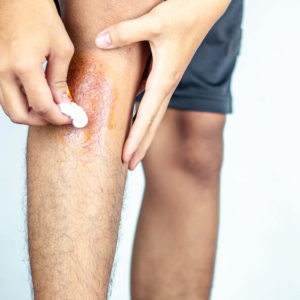Working with McIntyre Law

Deciding whether to settle with the insurance company or file a burn injury lawsuit can be a difficult choice for victims to make. Between medical treatment, lost and missed wages, and other living expenses, the costs of dealing with a burn injury can quickly add up.
At McIntyre Law, we’re committed to defending the rights of victims and fighting to get them and their families fair compensation. You don’t have to settle for less.
What is a contingency fee?
At McIntyre Law, we handle cases on a contingency fee basis. This means that we agree to accept a fixed percentage of any monetary awards from your burn injury lawsuit to cover our legal fees. If there are no rewards from your case, you don’t owe us anything. We only get paid when you do.
What types of burn injuries are the most common?
In order to effectively treat your burn, it’s important to know which type of burn injury you’re suffering from. Some of the common types of burn injuries are:
- Chemical burns. Chemical burns occur when a strong acid or alkali comes into contact with the skin or eyes.
- Thermal burns. Thermal burns occur when heat sources, such as hot metal or flames, raise the temperature of the skin.
- Friction burns. Friction burns occur when skin is rubbed or scraped off by contact with a hard surface, such as concrete or asphalt.
- Radiation burns. Radiation burns are caused by prolonged exposure to the sun’s ultraviolet rays or another source of radiation, such as X-rays.
- Electrical burns. Electrical burns occur when an electrical current runs through the body.
- Inhalation burns. Inhalation burns are due to breathing in hot, polluted air from a fire.
- Scald burns. Scald burns result from exposure to very hot water or steam.
A burn injury is also categorized by how severe the damage is. This is done by determining how many layers of the skin were penetrated. The different degrees of severity for a burn injury include:
- First-degree burns. First-degree burns are the least serious form of burn. They affect only the epidermis, the outermost layer of the skin. First-degree burns cause symptoms such as redness, pain, and swelling. These burns usually heal up on their own and rarely require medical attention.
- Second-degree burns. Second-degree burns cause damage to the epidermis and part of the layer of skin underneath it, known as the dermis. These burns result in redness, swelling, blistering, and intense pain. Second-degree burns are generally treated without surgery, but they may require a skin graft in more severe cases.
- Third-degree burns. Third-degree burns occur when all layers of the skin are destroyed, permanently damaging nerve endings, hair follicles, and sweat glands. Due to nerve endings being damaged, these burns usually aren’t painful but will lead to symptoms like charring, numbness, and leathery or white skin. A third-degree burn will likely require surgery and should always receive prompt medical attention.
- Fourth-degree burns. A fourth-degree burn is the most severe type of burn injury. These burns destroy all layers of the skin and damage the underlying bones, muscles, and tendons. Victims may also suffer serious nerve damage and symptoms such as intense charring, numbness, and loss of function. Fourth-degree burns lead to increased rates of amputation and death. They require immediate medical attention from a burn specialist.
Common burn injuries in the workplace
Burn injuries in the workplace are unfortunately common. A recent study showed that they account for 42% of all work-related injuries. Although there are some occupations at a higher risk, burn injuries can affect individuals working in any field. Some common types of workplace burn injuries include:
- Scalding from hot liquids or steam. Scalding is a leading type of burn injury in the United States, making up 34% of all cases reported between 2005 and 2014. If you suffered a scalding injury at work that someone else was responsible for, you may have grounds to take legal action against them.
- Chemical accidents. Chemical burns account for 16% of all work-related burns. They’re most likely to affect individuals who frequently work around dangerous or corrosive chemicals, such as industrial and agricultural workers. If your burn injury is cosmetic and doesn’t impact your ability to work, your employer may deny your workers’ compensation claim. That’s why it’s important to get help from a workers’ compensation attorney.
- Electrocutions. Electrical burns affect people in all different occupations, accounting for over 1,500 workplace injuries in the year 2018. Construction workers are at a high risk for electrical burns, accounting for 20% of all nonfatal electrical injuries. Employers have an obligation to warn employees about potential hazards and maintain a safe workplace. If your employer failed to inform you of a hazard that led to your workplace burn injury, you should speak with a lawyer right away about getting compensated.
- Gas explosions. Gas is a commonly used resource throughout the manufacturing and industrial industries. But its risks sometimes go overlooked and lead to injuries that could have been prevented. If poor maintenance, inadequate manufacturing, or someone else’s carelessness led you to suffer a gas-related burn injury at work, getting compensation for those injuries may require the help of a personal injury attorney.
Long-term effects of burn injuries

Victims who suffer more severe burn injuries often experience serious, costly, and lifelong health problems as a result. The long-term effects of a burn injury include:
- Scarring and disfigurement. Following a burn injury, skin will scar or become discolored, leading to permanent changes in physical appearance.
- Loss of limbs. In more severe cases, damaged limbs may have to be amputated in order to control pain and limit the spread of disease.
- Loss of mobility or physical function. If a burn injury reaches muscle or bone, it will result in a loss of mobility and physical function in the affected areas.
- Nerve damage. When skin is severely burned, the nerve endings controlling physical sensation are destroyed. That can lead to numbness, burning sensations, and sensitivity to touch.
- Organ damage. Upon suffering a burn injury, the body triggers an inflammatory response to try to heal itself. In some severe burn cases, the body can overreact by limiting the amount of oxygen flowing to organs, which increases the risk of damage.
- Increased risk of infection. Severe burns damage the skin’s protective layer, resulting in an increased risk of infection. Infections may target the injured area or appear elsewhere in the body, such as the lungs (pneumonia) and the bloodstream (sepsis).
- Increased risk of cancer. Burn injuries tend to weaken the immune system, which can lead to an increased risk of several types of cancer.
- Psychological trauma. Experiencing a burn injury can cause emotional and psychological problems such as depression, flashbacks, post-traumatic stress disorder (PTSD), and low self-esteem.
- Inability to work. More severe burn injuries can leave victims permanently disabled and out of work. The loss of income makes it difficult to handle the cost of ongoing medical treatments.
Common causes of burn injuries
According to the American Burn Association, 486,000 Americans receive medical treatment for burn injuries every year. A burn injury can occur at any time and may result from a number of different events. Some of the common causes of burn injuries include:
- Fires. Fires and open flames are the leading cause of burn injuries in the United States, accounting for approximately 43% of cases between 2005 and 2014. If you were burned in a hotel or apartment fire, you may be able to hold the owner or landlord legally responsible for your damages.
- Auto accidents. Whether it’s a car accident or truck accident, there’s a high risk of explosions, heat exposure, and smoke inhalation following a vehicle crash. If you were burned in an accident that resulted from someone else’s negligence, the driver responsible for the crash could be held accountable.
- Falling off a bike or motorcycle. Being involved in a bicycle accident or motorcycle accident will often result in severe road rash, a common type of friction burn.
- Defective products. Whether by overheating, creating sparks, or combusting, it’s possible for a defective product to cause a burn injury. If you got a burn injury after using a faulty product, you may be eligible to file a product liability claim.
- Workplace fires. Approximately 3,340 fires occur in office properties and other work environments around the United States each year. In 2018, fires and explosions led to 115 employee deaths. If you were injured in a workplace fire, you’re entitled to receive worker’s compensation benefits. However, if a third party contributed to your injuries, you can also hold them accountable with a personal injury lawsuit.
- Oil field accidents. Oil fields are naturally dangerous work environments. Companies that extract oil or gas accounted for 74% of all fatalities in the mining sector in 2015. Factors such as long working hours, worn-out electrical materials, and outdated or defective equipment all contribute to the high number of burn injuries that occur in oil fields. Oil field accident lawsuits are tricky in that you can’t sue the company you work for. But an attorney can help you file a lawsuit for negligence if any third parties, such as equipment manufacturers or coworkers, were responsible for your injuries.

Meet Our Burn Injury Attorneys
If you or a loved one suffered a burn injury, the team at McIntyre Law can defend you. Our burn injury attorneys have the knowledge and experience you need to get fair compensation for your damages. Get your burn injury claim started today.
What kind of compensation can you get for a burn injury?
There are many factors that affect the amount of your burn injury compensation, such as the extent of your injuries, the location of your burn, the costs of treatment, and whether serious negligence contributed to the accident. If your burn injury occurred at work, compensation may not cover noneconomic damages unless you file a separate personal injury lawsuit against a negligent party.
Since these cases can get complex, working with a burn injury lawyer will give you the best chance of collecting a higher settlement. Some common types of burn injury compensation include:
- Medical bills. Including hospitalizations, surgeries, medications, and other ongoing treatments.
- Lost wages. For the hours you were unable to work because of your burn injury.
- Travel expenses. To and from specialized burn care centers, if applicable.
- Pain and suffering. For the physical, emotional, and mental trauma your burn injury caused.
- Punitive damages. If negligence played a role in your injury, the defendant may be required to pay you for punitive damages.






